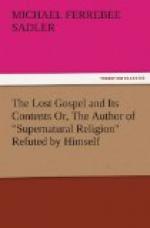wanting in the narrative the account of the things
done by Christ among the first of His deeds, and
at the commencement of the Gospel. And this was
the truth. For it is evident that the other
three Evangelists only wrote the deeds of our
Lord for one year after the imprisonment of John the
Baptist, and intimated this in the very beginning
of their history. For after the fasting of
forty days, and the consequent temptation, Matthew
indeed specifies the time of his history in these
words, ’But, hearing that John was delivered
up, he returned from Judea into Galilee.’
Mark in like manner writes: ’But, after
John was delivered up, Jesus came into Galilee.’
And Luke, before he commenced the deeds of Jesus,
in much the same way designates the time, saying,
’Herod thus added this wickedness above all
he had committed, and that he shut up John in
prison.’ For these reasons the Apostle John,
it is said, being entreated to undertake it, wrote
the account of the time not recorded by the former
Evangelists, and the deeds done by our Saviour,
which they have passed by (for these were the events
that occurred before the imprisonment of John),
and this very fact is intimated by him when he
says, ’This beginning of miracles Jesus made,’
and then proceeds to make mention of the Baptist, in
the midst of our Lord’s deeds, as John was
at that time ’baptizing at Aenon, near to
Salim.’ He plainly also shows this in the
words, ‘John was not yet cast into prison.’
The Apostle, therefore, in his Gospel, gives the
deeds of Jesus before the Baptist was cast into prison,
but the other three Evangelists mention the circumstances
after that event,” &c. (Bk. iii. c. xxiv.)
The last extract which I shall give is from the next chapter, when he mentions “The sacred Scriptures which are acknowledged as genuine, and those that are not:”—
“This appears also to be the proper place to give a summary statement of the books of the New Testament already mentioned. And here among the first must be placed the Holy Quaternion of the Gospels; these are followed by the Book of the Acts of the Apostles; after this must be mentioned the Epistles of Paul, which are followed by the acknowledged First Epistle of John, also the First of Peter to be admitted in like manner. After these are to be placed, if proper, the Revelation of John, concerning which we shall offer the different opinions in due time. These, then, are acknowledged as genuine. Among the disputed books, although they are well known and approved by many, is reputed that called the Epistle of James and [that] of Jude. Also the Second Epistle of Peter, and those called the Second and Third of John, whether they are of the Evangelist, or of some other of the same name. Among the spurious must be numbered both the books called the Acts of Paul, and that called Pastor, and the Revelation of Peter. Besides these, the books called the Epistle of Barnabas, and what are called the Institutions of the Apostles.




